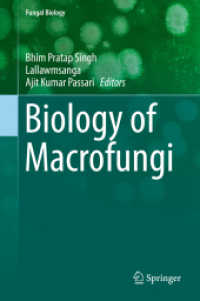- ホーム
- > 洋書
- > 英文書
- > Science / Mathematics
Full Description
The sublime evokes our awe, our terror, and our wonder. Applied first in ancient Greece to the heights of literary expression, in the 18th-century the sublime was extended to nature and to the sciences, enterprises that viewed the natural world as a manifestation of God's goodness, power, and wisdom.
In The Scientific Sublime, Alan Gross reveals the modern-day sublime in popular science. He shows how the great popular scientists of our time--Richard Feynman, Stephen Hawking, Steven Weinberg, Brian Greene, Lisa Randall, Rachel Carson, Stephen Jay Gould, Steven Pinker, Richard Dawkins, and E. O. Wilson--evoke the sublime in response to fundamental questions: How did the universe begin? How did life? How did language? These authors maintain a tradition initiated by Joseph Addison, Edmund Burke, Immanuel Kant, and Adam Smith, towering 18th-century figures who adapted the literary sublime first to nature, then to science--though with one crucial difference: religion has been replaced wholly by science.
In a final chapter, Gross explores science's attack on religion, an assault that attempts to sweep permanently under the rug two questions science cannot answer: What is the meaning of life? What is the meaning of the good life?
Contents
Chapter 1: Isn't Science Sublime?
Part I: The Physicists
Chapter 2: Richard Feynman: The Consensual Sublime
Chapter 3: Steven Weinberg: The Conjectural Sublime
Chapter 4. Lisa Randall: The Technological Sublime
Chapter 5. Brian Greene: The Speculative Sublime
Chapter 6. Stephen Hawking: The Scientific Sublime Embodied
Part II: The Biologists
Chapter 7. Rachel Carson: The Ethical Sublime
Chapter 8. Stephen Jay Gould's Books: The Balanced Sublime
Chapter 9. Stephen Jay Gould's Essays: Experiencing the Sublime
Chapter 10. Steven Pinker: The Polymath Sublime
Chapter 11. Richard Dawkins: The Mathematical Sublime
Chapter 12. E. O. Wilson: The Biophilic Sublime
Part III
Chapter 13. Move Over, God








